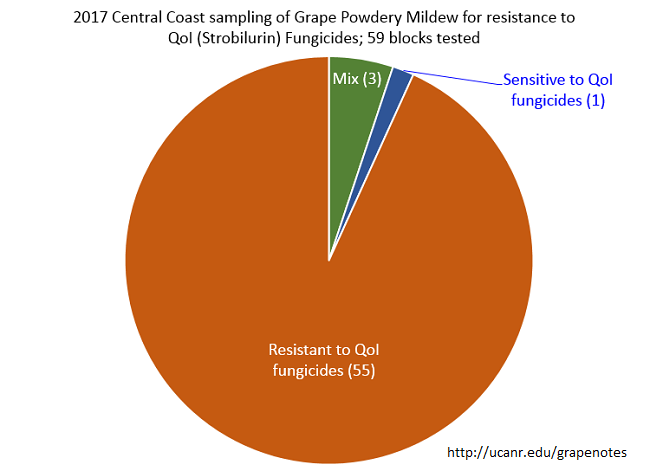The 2017 season had very challenging Grape Powdery Mildew conditions at many vineyards on the Central Coast. Crop losses of 80% or greater were observed at some of the most heavily impacted sites. The wet and overcast conditions in the spring were a primary factor leading to the heavy powdery mildew pressure. However, observed infection conditions were not necessarily uniform within regions; some vineyards suffered heavy infections while other nearby vineyards of the same variety had minimal problems which suggests that some control programs were much less effective than others. A constant concern is that powdery mildew can develop resistance to certain classes of fungicides that have a higher risk of such resistance occurring.
The development of resistance in powdery mildew to fungicides has occurred with previous chemistries. Triadimefon, myclobutanil, and fenarimol are examples of earlier fungicides that had delivered useful control of powdery mildew when first released but whose efficacy diminished over time as the organism developed resistance to their particular modes of action (1). To prevent powdery mildew from developing resistance to a particular fungicide it is critical to rotate modes of actions and to follow label rates. Fungicides are categorized into different FRAC (Fungicide Resistance Action Committee) groups, with products having similar modes of action being classed together. A summary of the FRAC groups and resistance risks is discussed on the UCCE Sonoma County website (2).
The Quinone Outside Inhibitor (QoI) fungicides, also referred to as Strobilurins, were commercialized in the 1990s. They offer control of a broad spectrum of fungal pathogens including Grape Powdery Mildew as well as Grape Downy Mildew. A weakness of the QoI fungicides is that they have a relatively simple mode of action at a single gene site on the chromosomes of their target fungal pathogens; thus they are more susceptible to having resistance develop through gene mutations as compared to fungicides with more complex modes of action. Such resistance to the QoI fungicides has already been observed in many fungal pathogens; a listing compiled by the FRAC in 2012 lists 36 different fungal pathogens of field crops that have shown resistance to the QoI fungicides (3). Grape Powdery Mildew resistance to QoI fungicides has previously been observed in Michigan, New York and Pennsylvania as well as other countries (4, 5). A thorough summary of the QoI fungicides and concerns about target fungal pathogens developing resistance is presented in the following article:
www.apsnet.org/edcenter/advanced/topics/Pages/StrobilurinFungicides.aspx (6)
Whether or not a particular population of powdery mildew is resistant to the QoI fungicides can be determined by testing for the presence of the specific gene mutation associated with resistance. Walt Mahaffee and Tara Neill at the USDA Horticultural Crops Research Unit in Corvallis, Oregon have been researching the status of QoI resistance in Grape Powdery Mildew. In support of this current work, powdery mildew samples from 59 vineyard blocks on the Central Coast were submitted for analysis in the summer and early fall of 2017. These samples were taken from sites having visible powdery mildew infections and so should not be considered as being representative of all powdery mildew in the region. Of these 59 samples, only one contained solely Grape Powdery Mildew which was sensitive to the QoI fungicides (non-mutant); this particular sample was taken from a home garden in the city of San Luis Obispo, and so likely had never been exposed to the QoI fungicides. Three samples contained a mix of both resistant and sensitive Grape Powdery Mildew, while the remaining 55 samples contained only QoI-resistant Grape Powdery Mildew. Thus, QoI-resistant Grape Powdery Mildew was observed at 100% of the tested commercial vineyard sites.
The ubiquitous presence of QoI-resistant Grape Powdery Mildew at the particular sites tested may have been an important factor in the relatively severe powdery mildew infections experienced at these sites in 2017. Growers in the region who have experienced similar problems in controlling powdery mildew should review their use of the QoI fungicides, as the survey results suggest a very high likelihood that other vineyards in the region that experienced problems controlling powdery mildew this season may also have powdery mildew populations that have developed resistance to the QoI fungicides.
Citations and further reading:
- Occurrence of resistance in Erysiphe necator to triadimefon, myclobutanil, and fenarimol in California grapevines. Gubler, W. D., Ypema, H. L., Ouimette, D. G., Bettiga, L. J. 1996 Plant Disease 80(8): 902-909
- Botrytis, Powdery Mildew, and Fungicide Resistance – UCCE Sonoma County
- List of pathogens with field resistance towards QoI fungicides (updated 12/09/12)
- QoI Resistance of Plasmopara viticola and Erysiphe necator in the Mid-Atlantic United States
- Strobilurin (QoI) Resistance in Populations of Erysiphe necator on Grapes in Michigan
- QoI (Strobilurin) Fungicides: Benefits and Risks
- Grape Powdery Mildew – UC IPM Website

